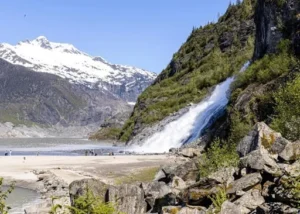Alaska, known as “The Last Frontier,” offers a unique business environment known for its rich natural resources, vast geography, and diverse cultural heritage. With a population of just over 730,000 and plenty of untapped potential, Alaska presents both exciting opportunities and challenges for entrepreneurs. To succeed here, it’s essential to understand the local economy, community needs, and the key factors that influence business in this remarkable state.
Understanding regional opportunities and challenges is crucial for business success in Alaska due to its unique environment and conditions. The state’s remote locations, harsh weather, and limited infrastructure require businesses to be adaptable and resourceful. Additionally, cultural sensitivity, particularly towards Indigenous communities, is vital for building strong relationships and trust. By recognizing these regional factors, entrepreneurs can tailor their strategies to meet local needs, overcome logistical hurdles, and create lasting value in the Alaskan market.
Demographics and Consumer Market Analysis
The population is projected to increase to 813,822 by 2045, with significant growth expected in the older age demographics. Alaskans tend to have a high rate of vehicle ownership, with an average of 2 cars per household and a commuting time of approximately 19.3 minutes. Alaska has experienced a trend of migration from rural to urban areas, with about 51% of the population residing in urban centers like Anchorage, Juneau, and Fairbanks.
Alaska’s economy is primarily driven by its abundant natural resources, including oil, gas, seafood, and minerals. The oil and gas industry remains a significant contributor, though it has faced fluctuations due to global market changes. Fishing and seafood processing are also key sectors, with Alaska supplying a large portion of the world’s wild-caught fish. Tourism is another vital industry, attracting millions of visitors each year with Alaska’s stunning landscapes and unique wildlife. In recent years, the state has seen growth in renewable energy, technology, and healthcare, as efforts to diversify the economy gain momentum.
Leading Business Opportunities in Alaska
Alaska holds 12% of the world’s coal reserves. The mining sector in Alaska is expected to continue growing, with ongoing interest in exploration due to the demand for metals, particularly from Asian markets. Alaska ranked 5th globally for investment attractiveness in mining and exploration.
1- Oil and Gas Exploration and Services

Alaska has long been a key player in the oil and gas industry, with vast reserves that have powered the state’s economy for decades. The North Slope and Cook Inlet regions are major hubs for oil production, contributing significantly to both state revenue and employment.
However, as global energy markets evolve, the industry faces challenges such as fluctuating prices and increasing regulatory scrutiny.
Companies that can innovate in areas like exploration technology, environmental protection, and sustainable practices are well-positioned to succeed in Alaska’s evolving energy landscape.
2- Renewable Energy Potential (Wind, Hydro, and Solar)

Alaska’s unique geography offers tremendous potential for renewable energy development. The state has some of the best wind resources in the country, especially in coastal and mountainous areas.
Hydropower is already a significant energy source, with numerous rivers and lakes providing clean energy to communities across the state.
Solar energy, while less prominent due to Alaska’s long winters, is gaining traction in rural and remote areas where traditional energy sources are costly or inaccessible. As the demand for clean energy grows, Alaska’s renewable resources present good business opportunities for businesses focused on sustainability.
3- Mining and Mineral Extraction

Alaska is rich in minerals, including gold, copper, zinc, and rare earth elements, making mining a critical industry.
The reported value of Alaska’s mineral industry in 2020 was approximately $3.2 billion, representing a 5% increase from 2019. This figure includes expenditures on exploration and development as well as revenue from commodities produced.
The state is home to some of the largest mining operations in the United States, with significant contributions to both the local and national economies. As global demand for minerals increases, especially for those used in technology and renewable energy, Alaska’s mining sector is poised for growth.
However, successful operations must balance economic gains with environmental stewardship and community engagement, particularly with Indigenous populations.
4- Tourism and Hospitality
Alaska’s wildlife and rich cultural heritage make it a top destination for travelers seeking unique experiences. The tourism and hospitality industry is a vital part of the state’s economy, attracting millions of visitors annually. Key attractions include the stunning Denali National Park, the Northern Lights, and the state’s vast wilderness areas, which offer opportunities for hiking, fishing, and wildlife viewing.
The cruise industry plays a significant role in the top business opportunities, with ships bringing thousands of visitors to Alaska’s coastal towns each summer. Adventure tourism, eco-tourism, and cultural tourism are also growing sectors, appealing to those interested in more personalized and immersive experiences.
However, the industry faces challenges such as a short tourist season, remote locations, and the need for sustainable practices to protect Alaska’s pristine environment. Businesses that can provide unique, high-quality experiences while promoting responsible tourism are likely to thrive. Additionally, there’s potential for growth in winter tourism, focusing on activities like dog sledding, skiing, and viewing the Northern Lights.
5- Seafood Processing and Export Opportunities
Seafood processing is a major industry in Alaska, providing year-round employment and contributing significantly to the state’s economy. With access to fresh, high-quality seafood, Alaska’s processors have a unique opportunity to add value through filleting, freezing, canning, and other methods.
The global appetite for Alaskan seafood continues to grow, especially in markets like Asia and Europe, with strong demand for premium, sustainably sourced products. Businesses that invest in efficient processing technologies, innovative packaging solutions, and direct export strategies can capitalize on these expanding markets.
As interest in sustainable, locally sourced foods grows, aquaculture provides a pathway for great business opportunities. Entrepreneurs who can navigate the regulatory environment and invest in environmentally responsible practices will find promising opportunities in Alaska’s growing aquaculture sector.
6- Agriculture and Local Food Production
Alaska’s agricultural sector, though small, is gaining attention for its niche markets in organic and specialty products. With increasing consumer demand for locally grown, high-quality foods, businesses have a growing opportunity to supply unique Alaskan produce, such as heirloom vegetables, herbs, and specialty berries. The state’s clean environment and short but intense growing season produce vibrant, nutrient-rich crops that appeal to health-conscious consumers. Farmers who can market their products as organic, non-GMO, or sustainably grown can tap into premium markets both locally and beyond.
Due to Alaska’s cold climate and short growing seasons, traditional farming can be challenging. However, innovations in greenhouse farming, hydroponics, and vertical farming are opening new doors for year-round production. These controlled environment agriculture techniques allow for the cultivation of fresh produce even during the harsh winter months, reducing dependence on imported goods and providing a fresh supply to local markets.
For businesses, investing in greenhouse technology can offer a stable, scalable solution to meet Alaska’s food needs while also creating new revenue streams.
7- Real Estate Business

Real estate opportunities in Alaska presents a lucrative opportunity for entrepreneurs and investors, driven by the state’s growing population, tourism sector, and unique geographical appeal.
Key opportunities lie in residential developments, vacation rentals, and commercial properties in high-demand areas like Anchorage, Fairbanks, and popular tourist towns. Vacation rentals, lodges, and cabins near national parks or scenic locations can generate substantial income, especially during peak tourist seasons.
Investing in commercial real estate, such as retail spaces or office buildings, also offers potential, particularly in urban centers where business activities are concentrated. Additionally, there’s growing interest in remote and off-grid properties, which appeal to those seeking an escape from urban life or a unique Alaskan experience.
However, success in Alaska’s real estate market requires understanding local market dynamics, zoning laws, and the challenges posed by the state’s harsh climate. Investors must be prepared to address logistical issues, such as transporting building materials to remote locations and maintaining properties in extreme weather conditions. Those who can navigate these challenges and adapt to Alaska’s distinctive environment will find real estate to be a highly rewarding business venture in the state.
Final Thoughts On Achieving Long-Term Success
In Alaska, the quickest way to become a millionaire often involves tapping into the state’s abundant natural resources and emerging industries. High-reward opportunities like investing in commercial fishing, seafood processing, or mining can generate significant income due to Alaska’s rich reserves and global demand for these products.
Renewable energy ventures, including wind, hydro, and solar projects, offer another rapid path to wealth as Alaska continues to harness its unique geography for sustainable power.
Tourism and adventure-based businesses, such as guided tours and eco-lodges, thrive on Alaska’s stunning landscapes and growing visitor numbers.
Real estate development, particularly in high-demand areas, and tech innovations catering to remote communities also present lucrative avenues. However, success in Alaska requires navigating environmental challenges, regulatory landscapes, and building strong local relationships—making it essential for entrepreneurs to be adaptable, innovative, and proactive in their business strategies.
FAQs
What are the most profitable industries for small businesses in Alaska?
The most profitable industries for small businesses in Alaska include tourism and hospitality, commercial fishing and seafood processing, real estate, renewable energy, and niche agriculture such as greenhouse farming. These industries thrive due to Alaska’s unique environment, natural resources, and growing market demand.
How can entrepreneurs navigate the logistical challenges of doing business in Alaska?
Entrepreneurs can navigate logistical challenges by investing in reliable transportation solutions, planning for weather-related disruptions, and leveraging technology to manage operations remotely. Partnering with local suppliers and using advanced inventory management systems can also help streamline logistics and reduce costs.
What government resources are available to support new businesses in the state?
Alaska offers various government resources for new businesses, including grants, loans, and technical assistance from the Alaska Small Business Development Center (SBDC), the Alaska Industrial Development and Export Authority (AIDEA), and the Alaska Department of Commerce, Community, and Economic Development. These organizations provide financial support, business training, and guidance.
How does the seasonal nature of Alaska’s economy affect business planning?
The seasonal nature of Alaska’s economy, particularly in tourism and fishing, requires businesses to plan for fluctuating demand. Entrepreneurs should focus on maximizing revenue during peak seasons and diversifying income streams in off-peak months. Effective cash flow management and flexible staffing strategies are essential to maintaining stability year-round.











